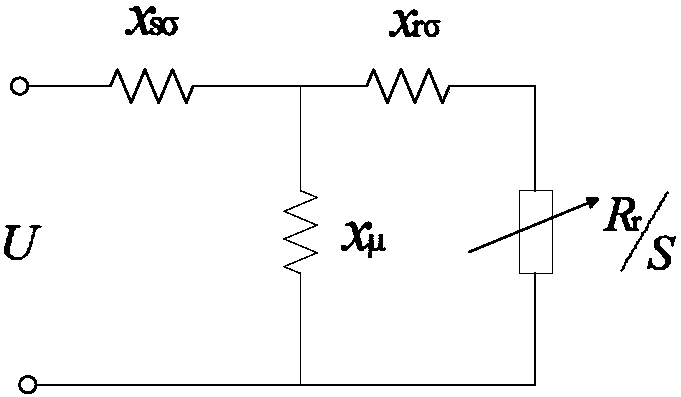Dynamic process analysis method of induction motor
A technology for induction motors and dynamic processes, applied to electrical components, circuit devices, AC network circuits, etc., can solve problems such as inconsistencies in calculation results, influence on simulation results, and system hazards, saving calculation time and workload, and clear physical meaning , the effect of fast calculation speed
- Summary
- Abstract
- Description
- Claims
- Application Information
AI Technical Summary
Problems solved by technology
Method used
Image
Examples
Embodiment 1
[0044] Embodiment 1: as Figure 1-2 As shown, a method for analyzing the dynamic process of an induction motor is characterized by: determining the expression of the mechanical torque of the induction motor; The relational expression of time; determine the value of the constant in the slip expression; get the trend of active power and reactive power changing with time in the dynamic process of the induction motor. The specific steps are as follows: Using the first-order mechanical transient model, the relationship between active power, reactive power and slip, frequency and voltage can be obtained through the T-shaped equivalent circuit. This relationship can be appropriately simplified as follows:
[0045] 1) Exciting circuit reactance x μ much greater than the stator reactance x sσ , namely x μ >>x sσ
[0046] 2) Ignore the stator and field circuit resistance
[0047] Through the above equivalent circuit diagram and simplified conditions, the following figure 1 The T-...
Embodiment 2
[0085] Embodiment 2: This embodiment takes a three-phase four-pole squirrel-cage rotor induction motor as an example. In this dynamic process analysis and calculation, a first-order mechanical transient model is used, and the analysis is carried out according to the method in Embodiment 1. The induction motor is The rotating magnetic field is generated by the three-phase current of the stator winding, and then the electromagnetic induction principle is used to generate the induced electromotive force and the induced current in the rotor winding, and the electromagnetic torque is generated by the interaction of the air gap magnetic field and the rotor induced current for energy conversion. The parameters are shown in Table 1.
[0086] Table 1 Induction motor operating parameter settings
[0087] parameter
The sum of stator inductance and rotor inductance (L 1 )
Exciting inductance (L μ )
Rotor inertia time constant (T j )
value
0.007248H
...
PUM
 Login to View More
Login to View More Abstract
Description
Claims
Application Information
 Login to View More
Login to View More - R&D
- Intellectual Property
- Life Sciences
- Materials
- Tech Scout
- Unparalleled Data Quality
- Higher Quality Content
- 60% Fewer Hallucinations
Browse by: Latest US Patents, China's latest patents, Technical Efficacy Thesaurus, Application Domain, Technology Topic, Popular Technical Reports.
© 2025 PatSnap. All rights reserved.Legal|Privacy policy|Modern Slavery Act Transparency Statement|Sitemap|About US| Contact US: help@patsnap.com



